Storm-Resistant Trees for Mississippi Landscapes
Mississippi has a humid, subtropical climate. Summers are long and hot, but winters are relatively mild. Prevailing southerly winds much of the year bring warm, humid air from the Gulf of Mexico across the state. Precipitation is distributed through the year with north Mississippi receiving about 55 inches and southern Mississippi about 65 inches. Southern Mississippi experiences more thunderstorms and hurricanes than the rest of the state.
The length of the state north to south spans several cold-hardiness zones, from 7b (5–10ºF average coldest temperatures) in north Mississippi to 9a (20–25ºF average coldest temperatures) on the coast. Mississippi also has its share of stormy weather. These include occasional ice storms in winter; high winds from thunderstorms, hurricanes, and tornadoes; flooding from torrential rains; and storm surges from hurricanes.
While native vegetation has adapted to a wide variety of environmental conditions, some species are better able to survive storm events than others. It makes sense to choose tree species for the landscape that can withstand these natural events. Storm-resistant trees will make your property safer and reduce future tree maintenance costs. This publication provides an overview of tree species that are capable of surviving winter ice, high winds, extensive flooding, and salt spray or seawater inundation. Very few tree species are resistant to all these storm conditions, so prioritize those that are most likely to impact your landscape.
Ice Resistance
Occasional ice storms in Mississippi can be devastating to trees. Such storms occur when the polar jet stream dips south in the winter. This phenomenon is known as the “Siberian Express,” and it brings arctic air and prolonged freezing temperatures to the state. If a wet warm front follows, then freezing rain and ice damage may result. In February 1994, a slow-moving front caused a severe ice storm in the Deep South—across Arkansas, Tennessee, Mississippi, and Alabama. Estimated damage was more than $3 billion, and a million people were without power, some over a month.
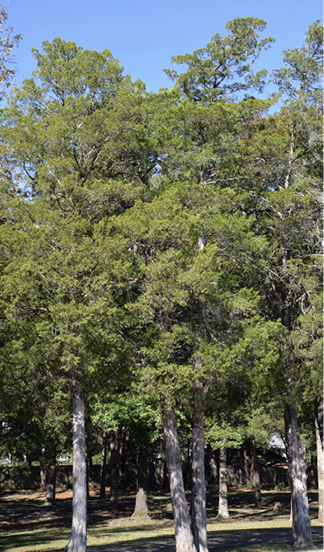
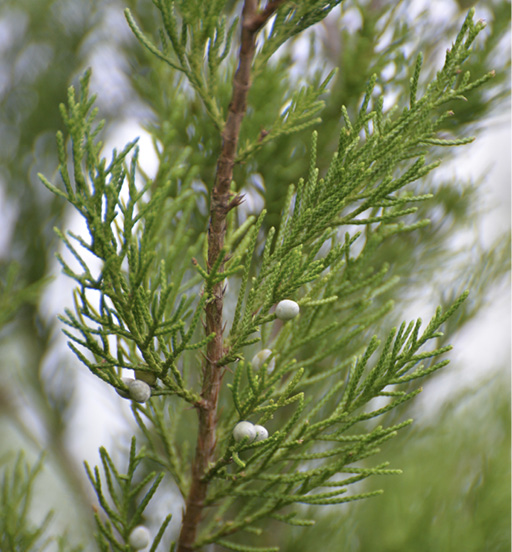
Tree species vary in their tolerance to ice accumulation. Those species most resistant to breakage from ice generally have strong branch attachment, flexible branches, low branch surface area, and straight trunks. Ice-tolerant species having one or more of these characteristics include bald cypress (Taxodium distichum), black walnut (Juglans nigra), and eastern redcedar (Juniperus virginiana; Figure 1).
Wind Resistance
Severe winds from thunderstorms are common in Mississippi, occurring an average of 55 days per year in northern counties and 75 days per year in southern counties. Storms occurring in late autumn and early spring may be associated with fronts having very high winds. Indeed, tornadoes often accompany these frontal systems crossing the state. Mississippi ranks eighth nationally in the frequency of tornadoes per 10,000 square miles. Hurricanes also bring very high winds; Mississippi has experienced 19 in the state since 1851.
Tree species vary widely in their ability to tolerate high winds, and the ability of any individual tree to survive wind will also depend on its health. However, there are some characteristics that enable trees to adapt to high wind. For instance, some tree species will defoliate during extreme winds, which increases their chances of survival. These include live oak (Quercus virginiana; Figure 2), flowering dogwood (Cornus florida), and crape myrtle (Lagerstroemia indica). Wood characteristics, such as high wood density or high elasticity, can help trees survive high winds. Live oaks have very dense wood. Some species with open crowns or pruned canopies survive high winds better. Trees with tapered crowns, such as eastern redcedar, have survived high winds.
Flood Tolerance
Flash flooding from torrential rain can become a problem when drainage is blocked in low areas and water covers the soil. Extended periods of flooding from overflowing rivers especially during the growing season can be very damaging to trees. In August 2005, Hurricane Katrina hit the Gulf Coast. It was one of the deadliest and most damaging hurricanes on record. Although the eye made landfall over Louisiana, the storm surge inundated the Gulf Coast from Mississippi to the Florida Panhandle. New Orleans was flooded by 20 feet of water after several levees broke. Damage from Louisiana to west Florida was estimated to exceed $100 billion.
Tree species have varying tolerance to flooding. Tree roots need oxygen, and most tree species will not tolerate flooding during the growing season. In addition, individual tree age impacts tolerance to flooding. Mature, vigorously growing trees of tolerant species are best able to withstand flooding. On the other hand, tree seedlings may not survive being covered with siltation from river flooding. Bald cypress (Taxodium distichum; Figure 3) is an example of a flood-tolerant tree. It is a relatively slow-growing tree commonly found on wet sites near flowing streams or rivers. This deciduous conifer’s needles drop in the autumn.
Salt Tolerance
Most land plants are adapted to fresh water. Since Mississippi experiences abundant rainfall through the year, saline soils are usually not a problem for our trees. However, trees in coastal counties regularly experience salt spray and seawater inundation.

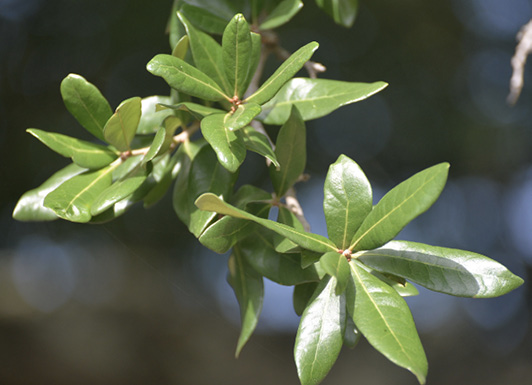
When ocean waves break or high winds whip whitecaps, the atmosphere carries particles of salt. This sea spray can be carried as far as 15 miles inland. Vegetation growing in coastal areas must be able to tolerate this salt. The sodium in salt spray or seawater can have detrimental effects on trees, including damaged or disfigured foliage, reduced growth, or even death. The American holly (Ilex opaca; Figure 4) is tolerant of salt spray.
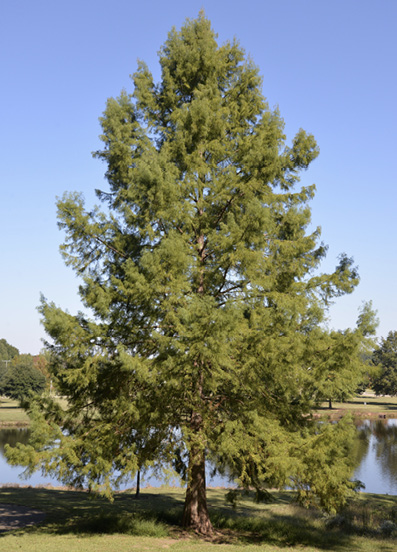

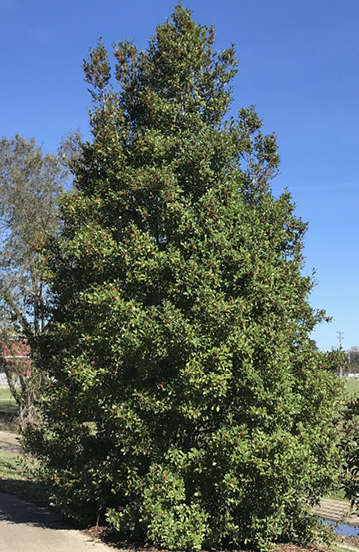
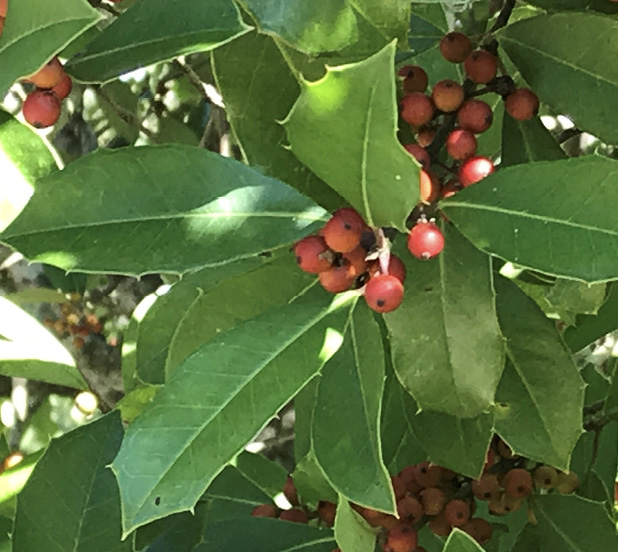
The other challenge to coastal vegetation is seawater contamination of fresh water and soils, which typically occurs along coastal creeks or rivers and barrier islands. The storm surge from hurricanes or tropical storms may contaminate soils and fresh water as far as 30 miles inland. This can be a problem for forested wetlands because these areas drain slowly.
Other potential sources of salt contamination of soil and runoff include the salt used to remove ice from roads and highways and fertilizers on cultivated areas. This is usually temporary because Mississippi’s abundant precipitation leaches salt through the soil. Leaching varies with soil texture and drainage, occurring more effectively in sandy soils than clay.
Too much salt in the soil can have multiple environmental effects. It can interfere with water absorption by plant roots, leading to death. High levels of salt can also degrade soil structure and lead to compaction, which decreases plant root respiration and expansion. Incorporating more organic matter into the soil can help prevent compaction. The southern magnolia (Magnolia grandiflora; Figure 5) tolerates saline soil and salt spray. It is an evergreen hardwood as well as the state tree and flower.
Storm-Resistant Trees
Table 1 presents relative storm resistance for established trees with well-developed root systems. Individual trees will vary in their ability to survive storm damage, so use Table 1 as a guide. The major common name for a tree is given, followed by its scientific name in italics. The taxonomy presented is in accordance with the United States Department of Agriculture, Natural Resources Conservation Service, National Plants Database. Table 1 also provides information on ice and wind resistance, as well as tolerance to flooding, salt spray, and saline soil. The book Mississippi Trees has photos of most of the trees on this list.
Not all trees listed will grow everywhere in Mississippi. It is important to match tree preferences with the landscape characteristics. Some species, like southern redcedar (Juniperus virginiana var silicicola) will only grow in coastal Mississippi. On the other hand, Chickasaw plum (Prunus angustifolia) will grow throughout most of the state except the Delta region and coastal counties.
Several tree species that are resistant to storm stresses are not necessarily suitable to plant for other reasons. Among these are green ash (Fraxinus pennsylvanica) and white ash (Fraxinus americana), which are susceptible to the emerald ash borer (EAB; Agrilus planipennis). Once this borer attacks an ash, the tree will die within a few years. The EAB has not yet been documented in Mississippi but has been found in all adjacent states.
Other trees have brittle wood and should not be planted near structures, driveways, or roads. These include boxelder (Acer negundo), eastern cottonwood (Populus deltoides), red maple (Acer rubrum), and silver maple (Acer saccharinum). Finally, make sure your selected tree is not an invasive plant. Chinese tallow (Triadica sebifera) is wind resistant but also a nonnative invasive. If you’re not sure, contact your local MSU Extension agent.


|
Tree |
Species |
Ice resistant1 |
Wind resistant2 |
Flood tolerant3 |
Salt spray tolerant4 |
Saline soil tolerant4 |
|
American beech |
Fagus grandifolia |
yes |
||||
|
American holly |
Ilex opaca |
yes |
yes |
|||
|
American hornbeam |
Carpinus caroliniana |
yes |
yes |
|||
|
American sycamore |
Platanus occidentalis |
yes |
yes |
|||
|
American witchhazel |
Hamamelis virginiana |
yes |
||||
|
Bald cypress |
Taxodium distichum |
yes |
yes |
yes |
yes |
yes |
|
Bitternut hickory |
Carya cordiformis |
yes |
||||
|
Black cherry |
Prunus serotina |
yes |
||||
|
Black locust |
Robinia pseudoacacia |
yes |
yes |
|||
|
Black walnut |
Juglans nigra |
yes |
yes |
yes |
||
|
Black willow |
Salix nigra |
yes |
||||
|
Blackgum |
Nyssa sylvatica |
yes |
yes |
yes |
||
|
Boxelder |
Acer negundo |
yes |
||||
|
Bur oak* |
Quercus macrocarpa |
yes |
yes |
|||
|
Cabbage palm |
Sabal palmetto |
yes |
yes |
yes |
||
|
Carolina laurelcherry |
Prunus caroliniana |
yes |
||||
|
Chaste tree* |
Vitex agnus-castus |
yes |
||||
|
Chickasaw plum |
Prunus angustifolia |
yes |
||||
|
Chinese magnolia* |
Magnolia × soulangiana |
yes |
||||
|
Common buttonbush |
Cephalanthus occidentalis |
yes |
||||
|
Common persimmon |
Diospyros virginiana |
yes |
yes |
yes |
yes |
|
|
Crapemyrtle* |
Lagerstroemia indica |
yes |
||||
|
Dahoon |
Ilex cassine |
yes |
||||
|
Eastern cottonwood |
Populus deltoides |
yes |
||||
|
Eastern redbud |
Cercis canadensis |
yes |
||||
|
Eastern redcedar |
Juniperus virginiana |
yes |
yes |
yes |
||
|
Eastern swamp privet |
Forestiera acuminata |
yes |
||||
|
Farkleberry |
Vaccinium arboreum |
yes |
||||
|
Flowering dogwood |
Cornus florida |
yes |
||||
|
Green ash |
Fraxinus pennsylvanica |
yes |
yes |
|||
|
Honey locust |
Gleditsia triacanthos |
yes |
yes |
yes |
||
|
Hophornbeam |
Ostrya virginiana |
yes |
yes |
|||
|
Inkberry |
Ilex glabra |
yes |
yes |
|||
|
Japanese maple* |
Acer palmatum |
yes |
||||
|
Laurel oak |
Quercus laurifolia |
yes |
||||
|
Live oak |
Quercus virginiana |
yes |
yes |
yes |
||
|
Longleaf pine |
Pinus palustris |
yes |
||||
|
Maidenhair tree* |
Ginkgo biloba |
yes |
yes |
|||
|
Mockernut hickory |
Carya tomentosa |
yes |
||||
|
Myrtle oak |
Quercus myrtifolia |
yes |
||||
|
Nuttall oak |
Quercus texana |
yes |
||||
|
Overcup oak |
Quercus lyrata |
yes |
||||
|
Pecan |
Carya illinoinensis |
yes |
yes |
|||
|
Pignut hickory |
Carya glabra |
yes |
yes |
|||
|
Pin oak |
Quercus palustris |
yes |
||||
|
Planertree |
Planera aquatica |
yes |
||||
|
Pond cypress |
Taxodium ascendens |
yes |
yes |
|||
|
Possumhaw |
Ilex decidua |
yes |
||||
|
Post oak |
Quercus stellata |
yes |
||||
|
Red maple |
Acer rubrum |
yes |
||||
|
River birch |
Betula nigra |
yes |
||||
|
Sand live oak |
Quercus geminata |
yes |
||||
|
Saw palmetto |
Serenoa repens |
yes |
yes |
|||
|
Shagbark hickory |
Carya ovata |
yes |
||||
|
Shumard oak |
Quercus shumardii |
yes |
||||
|
Silver maple |
Acer saccharinum |
yes |
||||
|
Slash pine |
Pinus elliottii |
yes |
||||
|
Southern catalpa |
Catalpa bignonioides |
yes |
||||
|
Southern crab apple |
Malus angustifolia |
yes |
yes |
|||
|
Southern magnolia |
Magnolia grandiflora |
yes |
yes |
yes |
||
|
Southern redcedar |
Juniperus virginiana var silicicola |
yes |
yes |
|||
|
Southern sugar maple |
Acer floridanum |
yes |
||||
|
Staghorn sumac |
Rhus typhina |
yes |
yes |
|||
|
Sugarberry |
Celtis laevigata |
yes |
||||
|
Swamp chestnut oak |
Quercus michauxii |
yes |
||||
|
Swamp white oak |
Quercus bicolor |
yes |
yes |
|||
|
Sweetbay |
Magnolia virginiana |
yes |
yes |
|||
|
Sweetgum |
Liquidambar styraciflua |
yes |
yes |
yes |
yes |
|
|
Turkey oak |
Quercus laevis |
yes |
||||
|
Water oak |
Quercus nigra |
yes |
yes |
|||
|
Water hickory |
Carya aquatica |
yes |
||||
|
Water locust |
Gleditsia aquatica |
yes |
||||
|
Water tupelo |
Nyssa aquatica |
yes |
yes |
|||
|
Wax myrtle |
Morella cerifera |
yes |
yes |
|||
|
White ash |
Fraxinus americana |
yes |
yes |
yes |
yes |
|
|
White fringetree |
Chionanthus virginicus |
yes |
yes |
|||
|
White oak |
Quercus alba |
yes |
yes |
|||
|
Willow oak |
Quercus phellos |
yes |
yes |
|||
|
Winged elm |
Ulmus alata |
yes |
yes |
|||
|
Yaupon |
Ilex vomitoria |
yes |
yes |
yes |
* Non-native ornamental.
1 Hauer, Wang, and Dawson (1993) evaluated damage to numerous species of urban trees after an ice storm by comparing to a pre-storm tree inventory. They found that tree form, strength of limb joints, and overall tree size were related to subsequent ice damage. Later, Hauer, Dawson, and Werner (2006) published a more comprehensive summary of their research on tree resistance to ice damage in urban forests. Their findings included assessments on tree species, age and form of the tree, and particularly the ability of tree branch junctures to withstand ice loads.
2 Duryea, Kampf, and Littell (2007) and Duryea and Kampf (2017) assessed tree damage resulting from nine hurricanes in Florida and Puerto Rico between 1992 and 2004, with sustained winds between 85 and 165 miles per hour. The first assessment surveyed homeowners regarding tree damage after Hurricane Andrew in 1992. For the remaining eight hurricanes, researchers surveyed arborists, urban foresters, and forest scientists.
3 Bratkovich, Burban, Katovich, Locey, Pokorny, and Wiest (1993) published an assessment of flooding effects on trees along the Mississippi and Missouri Rivers. Flood tolerance indicates that tree species are able to survive standing water through at least one growing season. Clatterbuck (2005) was an additional source for flood-tolerant trees.
4 Tolerance to salt spray and seawater inundation were compiled from the following sources: Appleton, Greene, Smith, French, Kane, Fox, Downing, and Gilland (2015); Ruter and Pennisi (2017); Smith 2019.
References
Appleton, B., Greene, V., Smith, A., French, S., Kane, B., Fox, L., Downing, A., & Gilland, T. (2015). Trees and shrubs that tolerate saline soils and salt spray drift. Virginia Cooperative Extension, Virginia Polytechnic Institute and State University, Publication 430-031.
Bratkovich, S., Burban, L., Katovich, S., Locey, C., Pokorny, J., & Wiest, R. (1993). Flooding and its effect on trees. United States Department of Agriculture, Forest Service, Northern Area State & Private Forestry.
Clatterbuck, W. K. (2005). Shade and flood tolerance of trees. University of Tennessee, Ag Extension Service, Publication SP 656.
Clatterbuck, W. K., & Fare, D. C. (1998). Trees to reconsider before planting. University of Tennessee, Ag Extension Service, publication SP 512.
Department of Geosciences, Mississippi State University. (n.d.) Mississippi climate.
Duryea, M. L., Kampf, E., & Littell, R. C. (2007). Hurricanes and the urban forest: I. Effects on southeastern United States Coastal Plain tree species. Arboriculture & Urban Forestry 33(2), 83–97.
Duryea, M. L., & Kampf, E. (2017). Selecting Coastal Plain species for wind resistance. University of Florida, Institute of Food and Agricultural Sciences Extension, Publication FPR 119.
Hauer, R. J., Dawson, J. O., & Werner, L. P. (2006). Trees and ice storms: The development of ice storm-resistant urban tree populations (2nd ed.). UNL Digital Commons.
Hauer, R. J., Wang, W., & Dawson, J. O. (1993). Ice storm damage to urban trees. Journal of Arboriculture 19(4), 187–194.
Maddox, V., & Kelly, L. S. (2017). Selecting landscape trees with special comments on invasive and native plants. Mississippi State University Extension, Publication 2679.
Miller, J. H. (2003). Nonnative invasive plants of southern forests: A field guide for identification and control. USDA Forest Service, Southern Research Station, GTR SRS 062.
Mississippi Forestry Commission. (2016). Mississippi trees (2nd ed.).
Ruter, J. M., & Pennisi, B. V. (2017). Selecting salt-tolerant native trees for the Georgia coast. University of Georgia Extension, Bulletin 1477.
Smith, B. H. (2019). Salt-tolerant plants for the South Carolina coast. Clemson University, Plant & Garden Information Center, Fact sheet HGIC 1730.
United States Department of Agriculture, Natural Resources Conservation Service. (2019). National PLANTS Database.
United States Department of Agriculture, Natural Resources Conservation Service. (2023). Plant hardiness zone map.
Publication 3111 (POD-02-24)
Reviewed by Jeff Wilson, PhD, Assistant Professor, North Mississippi Research and Extension Center, from a previous edition by John D. Kushla, PhD, Extension/Research Professor (retired), North Mississippi Research and Extension Center.
The Mississippi State University Extension Service is working to ensure all web content is accessible to all users. If you need assistance accessing any of our content, please email the webteam or call 662-325-2262.


